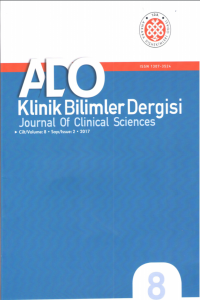Çene Kemiklerinin Bisfosfonatlara Bağlı Osteonekrozunda Teşhis ve Tedavi Yaklaşımları
Bisfosfonat, Maksilla, Mandibula, Osteonekroz
Diagnostic and Theraupeutic Approaches to Bisphosphonate- Related Osteonecrosis of the jaw
Bisphosphonate, Maxilla, Mandible, Osteonecrosis,
___
- )
- Fleisch H, Russell RG, Francis MD. Diphosphonates inhibit hydroxyapatite dissolution in vitro and bone resorption in tissue culture and in vivo.
- Science. 165(899):1262-4, 1969.
- Hellstein JW, Marek CL, Pharm BS. Bisphosphonate osteo- chemonecrosis (bis-phossy jaw): is this phossy jaw of the 21stcentury? J Oral Maxillofac Surg. 63:682-9, 2005.
- Marx RE, Sawatari Y, Fortin M, Broumand V. Bisphosphonateinduced exposed bone (osteonecro- sis/osteopetrosis) of the jaws: Risk factors, recognition, prevention and treatment. J Oral Maxillofac Surg.63:1567-75, 2005.
- American Association of Oral and Maxillofacial Surgeons Position Paper on Bisphosphonate-Related Osteonecrosis of the Jaws, Approved by the Board of Trustees,2006, Web
- on_papers/osteonecrosis.pdf
- Ruggiero SL, Mehrotra B, Rosenberg TJ, Engroff S. Osteonecrosis of the jaws associated with the use of bisphosphonates: a review of 63 cases. J Oral Maxillofac Surg. 62:527-34, 2004.
- Migliorati CA, Schubert MM, Petersen DE, Seneda LM. Bisphosphonate-associated osteonecrosis of mandibular and maxillary bone. An emerging oral complication of supportive cancer therapy. Cancer. 104:83-93, 2005.
- Dimitrakopoulos I, Magopoulos C, Karakasis D. Bisphosphonate-induced avascular osteonecrosis of the jaws: a clinical report of 11 cases. Int. J. Oral Maxillofac. Surg. 35: 588–593, 2006.
- Farrugia MC, Summerlin DJ, Krowiak E, Huntley T, Freeman S, Borrowdale R, Tomich C. Osteonecrosis of the Mandible or Maxilla Associated with the use of New Generation Bisphosphonates. Laryngoscope. 116(1):115- 20, 2006.
- Marx RE, Sawatari Y, Fortin M, Broumand V. Bisphosphonateinduced exposed bone (osteonecro- sis/osteopetrosis) of the jaws: Risk factors, recognition, prevention and treatment. J Oral Maxillofac Surg. 63:1567-75, 2005
- ) Durie BGM, Katz M, Crowley J. Osteonecrosis of the jaws and bisphosphonates. N Engl J Med. 353:99, 2005.
- ) Bamias A, Kastritis E, Bamia C, et al. Osteonecrosis of the jaw in cancer after treatment with bisphosphonates: inci- dence and risk factors. J Clin Oncol. 23:8580-7, 2005.
- ) Badros A, Weikel D, Salama A. Osteonecrosis of the jaw in multiple myeloma patients: clinical features and risk fac- tors. J Clin Oncol. 24:945-52, 2006.
- ) Hoff AO, Toth BB, Altundag K, et al. Osteonecrosis of the jaw in patients receiving intravenous bisphosphonate the- rapy. J Clin Oncol. 24:8528, 2006.
- ) Ruggiero SL, Fantasia J, Carlson E. Bisphosphonate-related osteonecrosis of the jaw: background and guidelines for diagnosis, staging and management. Oral Surg Oral Med Oral Path Oral Radiol Endod. 102(4):433-41, 2006.
- ) Andrade C, Martinez A, Walker S. Comparative Safety Evaluation of Non-narcotic Analgesics?. Journal of Clinical Epidemiology, 51(12):1357-1365, 2006.
- ) Slatkin N. Cancer-related pain and its pharmacologic management in the patient with bone metastasis. J Support Oncol. 4(2):15-21, 2006.
- ) Lin JH.Bisphosphonates: a review of their pharmacokinetic properties.
- Bone. 18(2):75-85, 1996.
- ISSN: 1307-3540
- Yayın Aralığı: Yılda 3 Sayı
- Başlangıç: 2006
- Yayıncı: Ankara Diş Hekimleri Odası
Immediate and Early Loading of Dental Implants
Anteriorda Dişsel Çapraz Kapanışın Tedavisi
Özge USLU, T. Ufuk Toygar MEMİKOLU
Dental İmplantlarda Başarı Kriterleri ve İmplant Sağlığının Sürdürülmesi
Şiddetli Sınıf III Bir Maloklüzyonun Cerrahisiz Ortodontik Tedavisi: Vaka Raporu
Aktinomikozis ile İlişkili Rekürrent Piyojenik Granüloma Gravidarum
Long Face ve Gummy Smile’li Bir Olguda Bimaksiller Ortognatik Cerrahi Yaklaşım
Behçet EROL, Ferhan YAMAN, Serhat ATILGAN
İki Dentinogenezis İmperfekta Olgusunda Protetik ve Restoratef Tedavi Yaklaşımı
Maksiller ve Mandibular Odontojenik Enfeksiyonların Baş-Oyun Bölgesindeki Yayılım Alanları
Ektodermal Displazi ve Protetik Tedavi Seçenekleri
Çene Kemiklerinin Bisfosfonatlara Bağlı Osteonekrozunda Teşhis ve Tedavi Yaklaşımları
